Updated: 30-Jan-2020
"Bristol Aero Engines Ltd." started building engines in 1920 but it all started when in 1910 the "British Colonial Aeroplane Co." began to construct aircraft.
-Later it became “Bristol Aeroplane Co. Ltd.”.
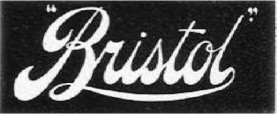
“Logo Bristol”
-Throughout its history it was absorbing companies. The first important one was "Armstrong-Siddeley" towards 1958 and the company was renamed "Bristol-Siddeley Ltd (Armstrong-Siddeley belonged to Hawker Siddeley Group at that time).

“Jupiter”
-At the same time, Bristol, entirely or partly, collaborated with, and built under license from other companies such as Gnome, Snecma (M-45), KHD, Fiat, Alfa-Romeo, Hindustan, GE, Turbomeca, SFA and many more.
-The products from the acquired brands made that Bristol's range of engines was one of the most important. Eventually, Bristol was incorporated into Rolls-Royce.

“Anuncio en Francia”
-It is convenient to deal here with the fact that in the Great War, Roy Fedden (later Sir) was technical director and chief engineer of Brazil-Straker, manufacturer of the Straker-Squire automobile engine and in times of war they also constructed the "Falcon", a 275 hp aircraft engine under license from Rolls-Royce for the Bristol fighter and the "Hawk" 100 hp engine for submarine-chaser dirigibles).
-In that period Fedden designed his own engines and when he left, the company became known as Cosmos Engineering Co. (see Cosmos).
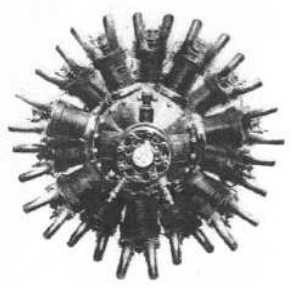
“Bristol-Cosmos”
-The first Bristol designs were precisely those from Cosmos.
-They were the “Mercury” that gave 315/347 hp, el “Jupiter” delivering 450 hp and the “Lucifer” with 100 hp.
-The first one that flew was the "Lucifer" and already in 1919 it was tested by Fedden on the Avro 504K.
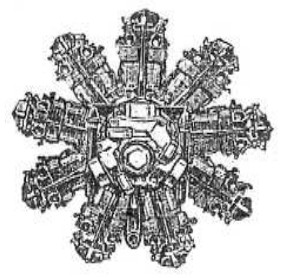
“Bristol Mercury, drawing”
-With natural development, the Mercury XIV reached 700 hp at 2,600 rpm and the XV model reached 840 hp at 2,750 rpm.
-The XX model delivered 850 hp at 2,650 rpm.
-When in 1920 the Cosmos rights were acquired by Bristol, they installed the Lucifer on the Bristol Monoplane (that during the war was fitted with the 110 hp "LeRhone"), winning in 1922 the Air Derby.

“Lucifer”
-The "Lucifer" was an air-cooled, 3-cylinder, inverted Y engine . It had four valves per cylinder, actuating in pairs.
-The "Lucifer" had several developments, the 118 hp, the 130 hp and in the case of "Lucifer" IV, it was 140 hp.
-The "Mercury" that actually was the first project, was a 9-cylinder radial engine.
-The "Jupiter" was Fedden's second design that even had more power initially. It was in the range of 450 hp.
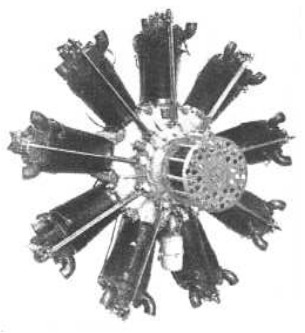
“Bristol Jupiter, rear view”
-The evolution of the "Mercury" and "Lucifer" was also applied to the "Jupiter", which furthermore proved to be an engine of success.
-This "Jupiter" evolution lasted until WWII, with conventional accessories such as reduction gear, 1- and 2-speed superchargers and turbo chargers,

“Supercharged Jupiter”
-Below, we can see the turbocharged "Jupiter". We see that the exhaust ducts come together and continue towards the turbo on the top.

“Jupiter turbocharged”
-The Jupiters that were fitted on the Blenheims were already in the range of 800/900 hp while the "Mercury XXXI" reached 950 hp when installed, curiously, in a Hamilcar glider.
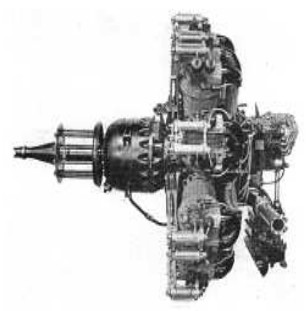
“Jupiter VIII F”
-In this early period there was also the "Cherub", which was the lightest of all early Bristol engines with two horizontally opposed cylinders. The Cherub I gave 25 hp at 2,500 rpm, the Cherub II gave 34 hp at 4,000 rpm and the third delivered 32 hp at 2,900 rpm.
-The Cherub model evolution we see in the two figures below. The first one has straight and simple lines.

“Cherub, first versions”
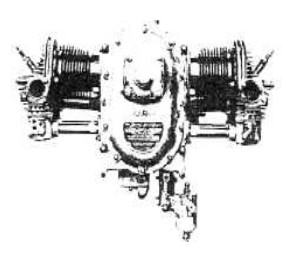
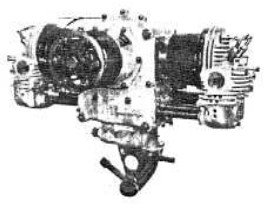
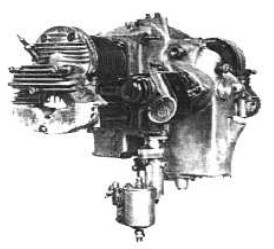
“Three Cherub I views”
-As it was fitted on many light aircraft, the "Cherub" also had a resounding success.
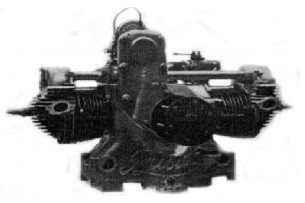
“Another Cherub variant”
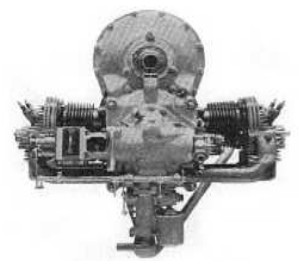
“Cherub III, with gear”
-The "Titan", a 5-cylinder radial engine that gave 200 hp, had few applications compared to its fellow engines, but there is no doubt that it helped with their experiences.
-The engine size was small as we can see by the propeller hub.
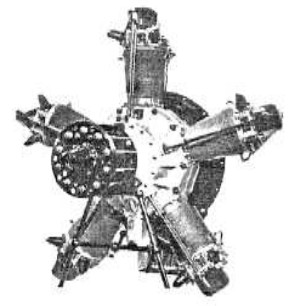
“Titan”
-The "Neptune" was a rather unknown radial engine that had seven cylinders. It was from 1929 and delivered 300 hp.

“Neptune”
-In 1934, the Bristol Phoenix appears, a supercharged radial Diesel engine with a power output of 635 hp.
-Diesel engines require some supercharge to maintain power at high altitudes, because the power decreases rapidly as during ascending air density decreases. So the low level needs to be restored and the cylinder has to be filled to the maximum so that when compressed, fuel ignition temperatures are reached.

“Bristol Phoenix”
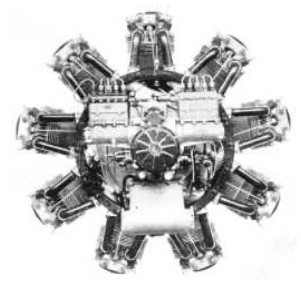
“Bristol Phoenix, rear view”
-In the Phoenix side view we see the front cover of the gearbox, and at the rear stand out the two monobloc diesel fuel injection pumps.
-The next engine was the "Orion" (this engine should not be confused with a later turboprop with the same name). In fact, the "Orion" was a turbocharged "Jupiter".
-The turbocharger is at the rear of the engine at a lower level.

“Bristol Orion”
-The "Pegasus" began its power career at 650 hp and in the beginning it was fitted on Vickers Valenta airplanes (successor of Victoria). The Pegasus 38 with a one speed supercharger already had the power increased to 1,000 hp.
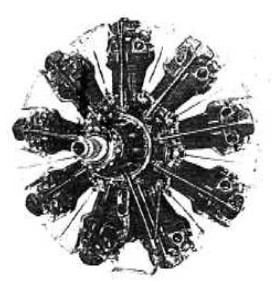
"Bristol Pegasus"
-The "Pegasus" was a 9-cylinder radial and large in size.
-And we use this chapter to show a clearer photograph of the Bristol Pegasus that gave 930 hp at 2,250 rpm.

"Bristol Pegasus"
-The "Draco" was another Pegasus Diesel derivative that was half supercharged. It had nine cylinders and also nearly the identical size.
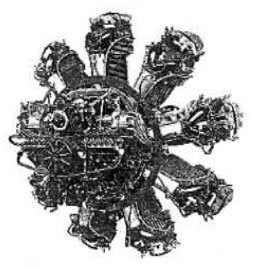
“Draco”
-And, in the realm of extraordinary engines, we reach the "Hydra", one of the brand's last conventional-valve engines with 16 relatively small cylinders in two radial rows, eight cylinders in each. They faced each other in a way that front and rear cylinders could use the same camshafts on the cylinder heads.
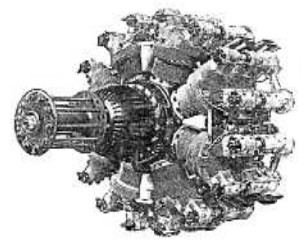
“Bristol Hydra”
-Geared it gave 870 hp at 3,620 crankshaft rpm. This engine did not go into production, for Bristol already concentrated its efforts on engines with sliding sleeves.
-The "Hydra" was called colloquially "Double Octagon".
-Bristol's sliding-sleeve piston engines are the ones with more charisma and which we remember most, against all the engines related in this chapter so far.
-Therefore we have two main groups: conventional-valve engines and sliding-valve engines.
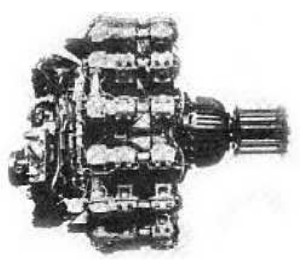
“Double Octogon or Hydra”
-There is mentioned the existence of an engine called Janus with centrifugal compressors and fitted back-to-back.
-These two groups can be listed as follows due to the unique mechanism of the latter:
-First group with conventional valves:
Mercury
Jupiter
Cherub
Lucifer
Titan
Neptune
Orion
Phoenix
Pegasus
Draco
Hydra
-Second group with sliding sleeves:
Perseus
Aquila
Taurus
Hercules
Centaurus
-The origin of the slide valves in Bristol dates back to 1926 when a new line of engines was planned.
-There are several systems of sliding sleeves, and most of them were rejected for their technical and mechanical complexity.
-In fact only two systems survived: Knight and Burt-McCollum, and Bristol decided for the latter.
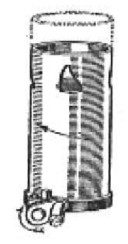
“Burt-McCollum sleeve”
-The first test was done with a two-cylinder V-engine, after some years of continuous testing, in 1930, they were ready to build an engine of this kind.
-The sliding sleeves were made of austenitic steel, so they could support their new job.
-The conventional valves had prospered because they were filled with sodium, which, when liquefying through the heat, aided cooling and prolong its life, as they were subjected to hard work and heat.
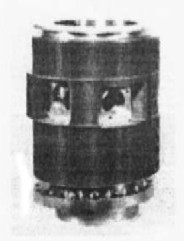
"Cylinder with sliding sleeves"
-With nitrided liner surfaces, the first experimental Bristol motor run at 2000 rpm for 10 hours, in March 1931.
-The most important step taken to advance this engine was the introduction, a year earlier, of a cylinder head with an integral deflector for the mixture turbulence around the spark plug. This process was followed in the following engines, including the Centaurus.
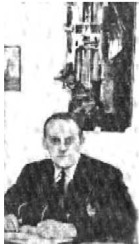
"Sir Roy Fedden"
-The person behind the development of these engines was the omnipresent Roy Fedden.
-Bristol's decision was forced by a number of comparative tests with conventional valves of similar sizes.
-Sleeve-valve engines admitted a higher compression ratio with an equal octane number in the fuel.
-They also improved the engine's atmospheric capacity in its final intake and exhaust stages.

"Bristol Perseus"
-The first sliding-sleeve engine at normal scale was the 9-cylinder, 25-liter engine called "Perseus I" (later the VIII model reached 825 hp and the X gave 950 hp).
-Comparing the Perseus sliding-sleeve cylinder and the Mercury poppet-valve cylinder, we list the following features.
-Perseus :
Diameter/Stroke, 5.75” x 6.5”
Displacement, 168.8 cu.in.
Fin surface area, 2970 in2.
Weight, 42.1 lbs.
m.e.p, 138 lb/sq.in.
rpm. max., 3200.
Mercury:
Diameter/Stroke, 5.75” x 6.5”
Displacement, 168.8 cu.in.
Fin surface area: 2364 in2.
Weight, 46 lbs.
m.e.p, 130 lb/ sq.in.
rpm max., 3000.
-The “Perseus” was followed by the “Aquila”, the “Taurus” and the “Hercules”.
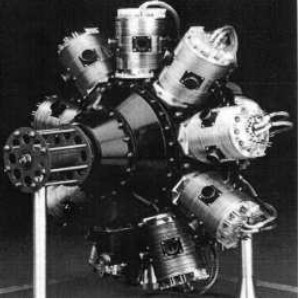
"Bristol Aquila"
-From the "Hercules", which was the one who had more luck, they derived the "Centaurus" as logical development and in search of more power.

"Bristol Aquila, rear view"

"Bristol Taurus"
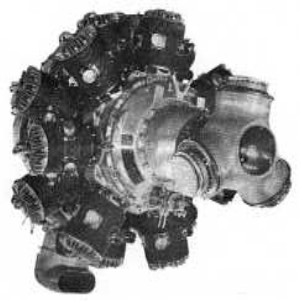
"Bristol Taurus"
-The Taurus we see above, with 14 cylinders in two rows, gear, and here in the picture, with three-bladed propeller hub without blades.
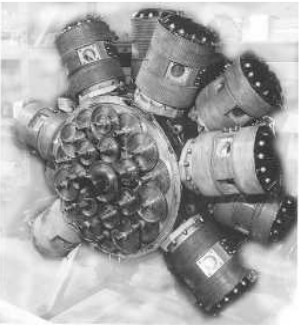
"Nice gear train on the Taurus"
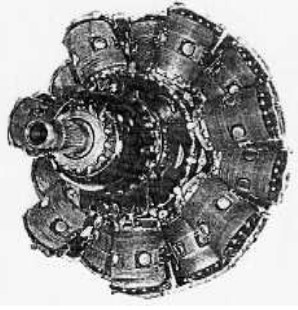
"Bristol Hercules"
-During WWII they planned to build twin-engined airplanes that were larger than the DH Mosquito and Beaufighter. One of these projects was the Avro Manchester with the "Centaurus" engine that was intended for that aircraft.
-However, because of the difficulty of obtaining great powers, initially four-engine bombers were designed, where, "Hercules" engines were widely used.
-The "Hercules" was built in countless versions in the range of 1,200 / 2,000 hp.
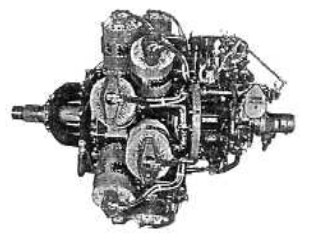
"Bristol Hercules"
-It went into regular operation in 1937 and in 1945 it had increased its capacity by 30% at the expense of only a 10% weight gain.
-The Mark II versions or series were fitted in the Beaufighter; the III, VI, VII and VIII in the Halifax, Lancaster II and Stirlings I, III and IV and also in the York II and in other variants such as Albermale I and II, Wellington, Sunderland, etc. They had 14 cylinders.
-Among the civilian aircraft they were mounted on HP (Handley Page) Hermes, Halifax Transport, Bristol Freighter, Bristol Wayfarer, Viking, ...
-In Spain they were fitted on CASA Azors, and in France it is known that the Noratlas Nords were fitted with them, but in France these engines were produced by Snecma under license.
-The Hercules 100, 120, 130 (series 100) were similar in power at takeoff: 1,675 hp, varying performances of maximum power and maximum continuous. The 630 already gave 1,800 hp.
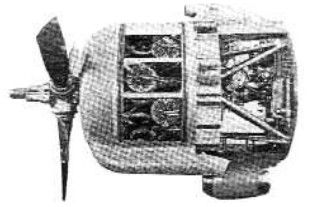
“Hercules Power Egg”
-The Hercules engines have been in production for many years and until recently they were in operation.
-On the Casa Azor and on the Noratlas (Nord 2501), the conventional, maximum performance fairing, known as "Power Egg", has not changed in essence. It remains essentially the same on the Sunderlands, etc.
-Sleeve-valve engines have little frontal area, as the cylinders do not have heads with valves, which makes the fairing ring to have less diameter and be significantly smaller.
-In many cases the cooling air is forced with front fans that are fitted on the propeller hub.

"Bristol Centaurus"
-The "Centaurus" accumulated 2,500/2,800 hp with 18 cylinders in two rows with a two-speed supercharger.
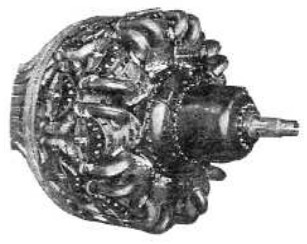
"Bristol Centaurus"
-By 1945 the "Centaurus" was only 3'3 inches more in diameter than the "Hercules", it was one of the most powerful engines in the world at that time and at the end of the war there was a comparison table with the following engines:
| W. Cyclone R3350 | 18 cyls. | 55.1 | lts. |
| Napier Sabre | 24 cyls. | 36.6 | lts. |
| PW D-Wasp R-2800 | 18 cyls. | 45.9 | lts. |
| DB 603 | 12 cyls. | 44.5 | lts. |
| Hercules | 14 cyls. | 38.7 | lts. |
| RR Griffon | 12 cyls. | 36.7 | lts. |
| Centaurus | 18 cyls. | 55.6 | lts. |

"Centaurus, accessory side"
-From the Centaurus 660 series, the 661 and its military version (the -165) are presented below. These pictures are taken from the factory's presentation catalog.
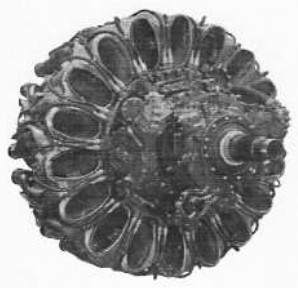
"Centaurus 661"
-Each of the 18 cylinders is placed within an integral deflector giving the engine a completely different look than usual. It has 3,270 cubic inches of displacement. The military version had water/methanol injection for takeoff.
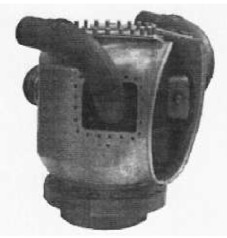
“661 cylinder”
-The Centaurus had its most outstanding applications in the Tempest II fighter, the Shetland seaplane, in the Warwick V and the "Double Centaurus" version with 5,000 hp for the Bristol 167 "Brabazon" with contra-rotating propellers.
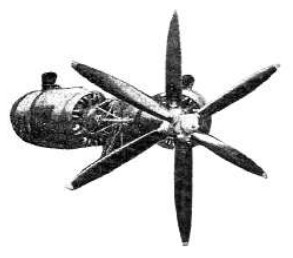
"Double-Centaurus"
-To complement the picture of the two Centaurus engines for the Brabazon aircraft, below, we show the whole in a diagram, with its gearbox and transmissions for the two contra-rotating propellers.
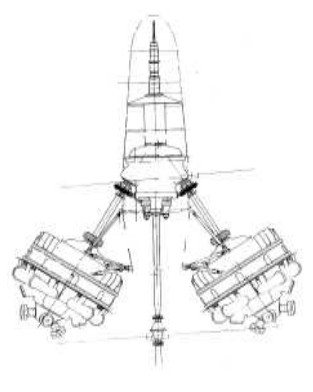
"Double Centaurus diagram"
-The "Saturn" (BE-22) that gave 3750 lbs. of thrust, went on the Folland Gnat.
-The "Zephyr" was a commercial two-shaft turbojet derived from the Olympus 2000, and delivered a thrust of 16,000 lbs.
-Other information indicates that it was the proposed name for the Orion when it was passed to Wright (USA).
-Reviewing sleeve-valve engines, we go back in time to show some piston engine ads such as this Perseus one from 1939.
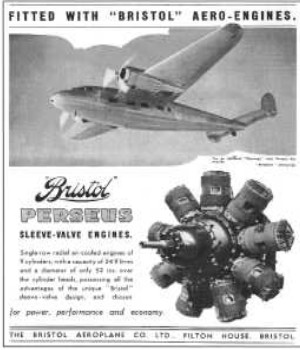
"Bristol Perseus ad"
-And the Bristol Taurus and Hercules ad from 1942, during WWII.
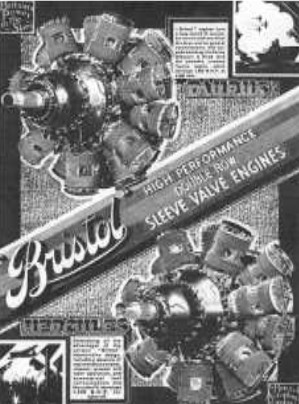
"Bristol ad during WWII"
-Towards the end of WWII, Roy Fedden initiated the study and construction of another "Orion" that had 18 cylinders and a displacement of 4142 cubic inches, rated for 4000 hp, but ....
-Bristol started its entry into the turbine era with turboprop "Theseus", although confidences within the company mention early experiments with gas turbines in 1924.
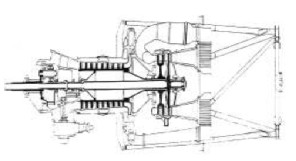
"Theseus diagram"
-However, the Theseus is from 1945.
-It was the first officially approved turbine in turboprop version in the world.
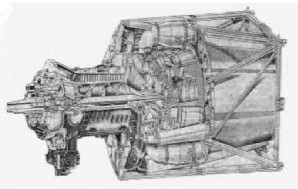
"Theseus, cutaway"
-It made the first flight occupying the outboard engines of an Avro Lincoln.
-The Type I's power was 1950 SHP (hp at shaft) plus 500 lbs. of thrust provided by the exhaust.
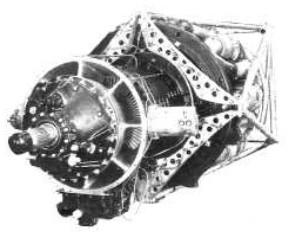
"Theseus"
-A double turbine drove a 9-stage axial compressor and one centrifugal compressor. A third turbine drove a 4-blade propeller (initially).
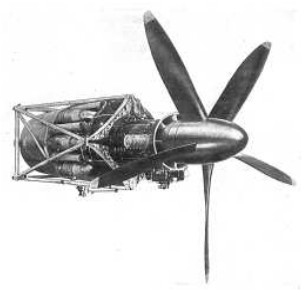
"Theseus with 5-blade propeller"
-The twin-Theseus, or "Double-Theseus" was fitted on the "Brabazon II".
-The Bristol "Proteus" was produced after the experiences with the "Theseus", under direction of Chief Engineer F. W. Owner.
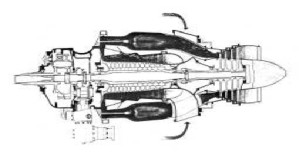
"Proteus diagram"
-The "Proteus" is characterized by its reverse flow compressor. It delivers over 4,000 SHP and has, until recently, its main application in the Bristol Britannia and the Canadair CL-44.
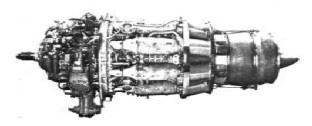

“Two views of a Proteus”
-From the Proteus they made a turbojet version called "Phoebus".
-The "Double-Proteus" was installed on the Princess, a huge Saunders-Roe flying boat.
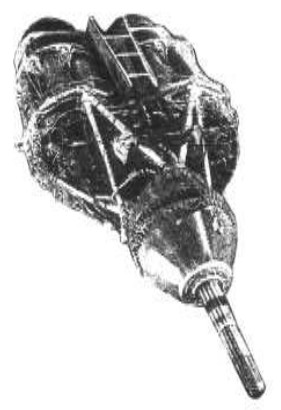
"Double - Proteus"
-The opposite is true for the B-25 that was a byproduct of the "Olympus". For example, the Olympus from which it was derived delivered 4990 Kgs. of thrust, and the BE-25 gave 4300 SHP at an altitude of 5300 meters.

"Bristol BE-25"
Engines of BRISTOL part 1
Model: Aquila
Arquitecture: 9-cylinder Radial
Cooling:
Total Displacement:
Bore / Stroke:
Power: @ rpm
Weight:
A sleeve-valve engine.

"Bristol Aquila, rear view"
Model: Artouste
Arquitecture: Turboshaft
Compressor/s:
Combustion chambers:
Turbines:
Power / Thrust:
Weight:
The Artouste was built under license from Turbomeca and was used as auxiliary turbine.
Model: Astazou
Arquitecture: Turboshaft
Compressor/s:
Combustion chambers:
Turbines:
Power / Thrust:
Weight:
The Astazou was a turboprop that was built under license from Turbomeca.
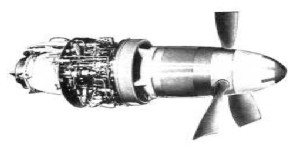
"Bristol Astazou"
Model: BE-25 (Orión)
Arquitecture: Turboprop
Compressor/s:
Combustion chambers:
Turbines:
Power / Thrust: 4300SHP / ---
Weight:
The B-25 was a byproduct of the "Olympus" and gave 4300 SHP at an altitude of 5300 meters.
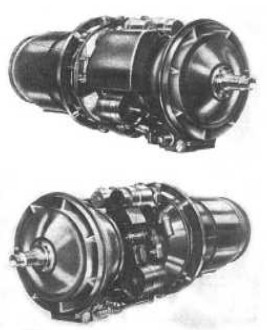
"Bristol - B.E.25 both sides at 3/4"
Model: BH estatos
Arquitecture: Ramjet
Chambers: 0
Fuels: 0
Feed System:
Ignition:
Thrust:
Weight:

"BH ramjet"
Model: Braemar
Model: BS-100
Arquitecture: Turbofan
Compressor/s:
Combustion chambers:
Turbines:
Power / Thrust: --- / 47000 Kgf
Weight:
The BS-100 is derived from BS.53/16. Thus it is a turbofan for vertical-takeoff (VTOL) aircraft.
It had PCB system or Plenum Chamber Burning consisting of an afterburner in the cold air bypass of the front adjustable nozzles.
Model: BS-347
Arquitecture: Turbojet
Compressor/s:
Combustion chambers:
Turbines:
Power / Thrust: --- / 140 Lbf
Weight:
A small Bristol engine that was used in target drones. It was built in the mid 1960's.
Model: BS-53
Arquitecture: Turbojet
Compressor/s:
Combustion chambers:
Turbines:
Power / Thrust:
Weight:
Turbojet with "Ducted Fan"
Model: BS-58
Model: BS-605
Arquitecture: Rocket engine
Chambers: 0
Fuels: 0
Feed System:
Ignition:
Thrust: 4000 Lbf
Weight:
The retractable Bristol Siddeley BS-605 was used for take off assist, climb, or combat on military aircraft.

"Bristol - BS-605"
Model: BS-75
Arquitecture: Turbojet
Compressor/s:
Combustion chambers:
Turbines:
Power / Thrust: --- / 7300 Lbf
Weight:
From 1960, equipped with a "Ducted Fan".
Model: BSRJ-824
Arquitecture: Ramjet
Chambers: 0
Fuels: 0
Feed System:
Ignition:
Thrust:
Weight:
This is a ramjet for high altitudes and supersonic speeds. From the early 60's. For the time being no applications are known.

"Bristol - RJ-824"
Model: BST-301
Arquitecture: Ramjet
Chambers: 0
Fuels: 0
Feed System:
Ignition:
Thrust:
Weight:
Model: BT-1 (Thor)
Arquitecture: Ramjet
Chambers: 0
Fuels: 0
Feed System:
Ignition:
Thrust:
Weight:
The BT-1 is a Thor version.
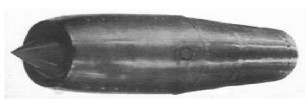
"Bristol BT.1"
Model: BT-2 (Thor)
Arquitecture: Ramjet
Chambers: 0
Fuels: 0
Feed System:
Ignition:
Thrust:
Weight:
The BT-2 is a Thor version.
Model: BT-30
Arquitecture: Ramjet
Chambers: 0
Fuels: 0
Feed System:
Ignition:
Thrust:
Weight:
Model: Centaurus y Doble Centaurus
Arquitecture: 18-cylinder Radial
Cooling: Air
Total Displacement: 3270 cu. in.
Bore / Stroke: 5.75 x 7 inch
Power: 2520 HP @ 2700 rpm
Weight:
The "Centaurus" had a two-speed supercharger.
From the Centaurus 660 series, the 661 and its military version (the -165) are presented below. These pictures are taken from the factory's presentation catalogue.
Each of the 18 cylinders is placed within an integral deflector giving the engine a completely different look than usual. The military version had water/methanol injection for takeoff.
There was a "Double Centaurus" version with contra-rotating propellers that delivered 5,000 hp .

"Bristol Centaurus 661"
Model: Cherub (Querubin)
Arquitecture: 2-cylinder Horizontally opposed
Cooling:
Total Displacement:
Bore / Stroke:
Power: 25 HP @ 2500 rpm
Weight:
The "Cherub" was the lightest of all early Bristol engines with two horizontally opposed cylinders. The Cherub I gave 25 hp at 2500 rpm, the Cherub II gave 34 hp at 4000 rpm and the third delivered 32 hp at 2900 rpm.

"Another variant of the Bristol Cherub"
Model: Cosmos (Lic)

"Bristol-Cosmos"
Model: Draco
Arquitecture: 9-cylinder Radial
Cooling:
Total Displacement:
Bore / Stroke:
Power: @ rpm
Weight:

"Bristol - Draco"
Model: Gamma 201 y 301
Arquitecture: Rocket engine
Chambers: 0
Fuels: Liquid
Feed System:
Ignition:
Thrust:
Weight:
The Gamma 201 (Mk-201) engine powers the Black Knight. The 301 is also a product of this series.
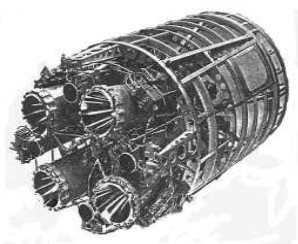
"Bristol Gamma 201"
Model: Gazelle
Arquitecture: Turboshaft
Compressor/s:
Combustion chambers:
Turbines:
Power / Thrust: 1600SHP / ---
Weight:
The "Gazelle" went to Westland helicopters.
Model: Ghost
Arquitecture: Turbojet
Compressor/s: Single stage centrifugal
Combustion chambers: 10 chambers
Turbines: single stage turbine
Power / Thrust: --- / 5000 Lbf
Weight:
Model: Gipsy I
Arquitecture: 4-cylinder In-line
Cooling: Air
Total Displacement: 318.1 cu. in.
Bore / Stroke: 4.5 x 5 inch
Power: 85 HP @ 1900 rpm
Weight: 285 Lb
Model: Gnome H-1000
Arquitecture: Turboshaft
Compressor/s: 0
Combustion chambers: 0
Turbines: 0
Power / Thrust: 1050SHP / ---
Weight:
The Gnome H-1000 was a turboshaft engine for helicopters.
Model: Gnome H-1200
Arquitecture: Turboshaft
Compressor/s: 0
Combustion chambers: 0
Turbines: 0
Power / Thrust: 1200SHP / ---
Weight:
The Gnome H-1200 was a turboshaft engine for helicopters.

"Bristol - Gnome P-1200"
Model: Gnome H-1400
Arquitecture: Turboshaft
Compressor/s: 0
Combustion chambers: 0
Turbines: 0
Power / Thrust: 1400SHP / ---
Weight:
The Gnome H-1400 was a turboshaft engine for helicopters.

"Bristol - Gnome H-1400"
Model: Gnome P- series
Model: Goblin
Arquitecture: Turbojet
Compressor/s: single sided, centrifugal
Combustion chambers: 16 chambers
Turbines: Single-stage axial
Power / Thrust: --- / 3000 Lbf
Weight:
Model: Gyron Junior
Arquitecture: Turbojet
Compressor/s: 7-stage axial flow compressor
Combustion chambers: Annular combustion chamber
Turbines: 2-stage axial flow turbine
Power / Thrust: --- / 10000 Lbf
Weight:
With afterburner
Model: Hercules
Arquitecture: 14-cylinder Radial
Cooling:
Total Displacement: 2360 cu. in.
Bore / Stroke: 5.75 x 6.5 inch
Power: 1356 HP @ 2750 rpm
Weight: 1929 Lb
The Hercules 100, 120, 130 (series 100) were similar in power at takeoff: 1,675 hp, varying performances of maximum power and maximum continuous. The 630 already gave 1,800 hp.

"Bristol Hercules"
Model: Hydra
Arquitecture: 16-cylinder Radial
Cooling:
Total Displacement:
Bore / Stroke:
Power: 870 HP @ 3620 rpm
Weight:
The "Hydra" was one of the brand's last conventional-valve engines with 16 relatively small cylinders in two radial rows of eight cylinders in each. They faced each other in a way that front and rear cylinders could use the same camshafts on the cylinder heads.

"Bristol Hydra"
Model: Janus
Arquitecture: Turboprop
Compressor/s: 0
Combustion chambers: 0
Turbines: 0
Power / Thrust:
Weight:
Model: Jupiter
Arquitecture: 9-cylinder Radial
Cooling:
Total Displacement:
Bore / Stroke:
Power: @ rpm
Weight:
The "Jupiter" initially was in the range of 450 hp.
Its evolution lasted until WWII, with conventional accessories such as reduction gear, 1- and 2-speed superchargers and turbo chargers.
The Jupiters that were fitted on Blenheims were already in the range of 800/900 hp while the "Mercury XXXI" reached 950 hp.
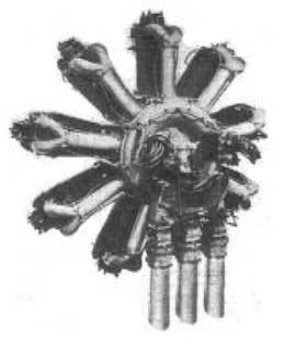
"Bristol - The Jupiter with its three carburetors"
Model: Lucifer
Arquitecture: 3-cylinder Inverted Y-engine
Cooling: Air
Total Displacement:
Bore / Stroke:
Power: @ rpm
Weight:
The "Lucifer" had four valves per cylinder, operating in pairs. It had several developments, the 118 hp, the 130 hp and in the case of "Lucifer" IV, it was 140 hp.

"Bristol - Lucifer"
Model: M-45 con Snecma
Arquitecture: Turbofan
Compressor/s: 0
Combustion chambers: 0
Turbines: 0
Power / Thrust:
Weight:
Model: Mercury
Arquitecture: 9-cylinder Radial
Cooling:
Total Displacement: 168.8 cu. in.
Bore / Stroke: 5.75 x 6.5 inch
Power: 315 /347 HP @ 3000 rpm
Weight: 46 Lb
This engine gave 315/347 hp in the beginning. The Mercury XIV reached 700 hp at 2600 rpm and the XV model delivered 840 hp at 2750 rpm. The XX model delivered 850 hp at 2650 rpm.

"Bristol Mercury front angle view"
Model: Neptune
Arquitecture: 7-cylinder Radial
Cooling:
Total Displacement:
Bore / Stroke:
Power: 300 HP @ rpm
Weight:

"Bristol - Neptune"
Model: Nimbus
Arquitecture: Turboshaft
Compressor/s: 2-stage axial and single stage centrifugal
Combustion chambers: Annular combustion chamber
Turbines: Two-stage axial gas generator, single-stage power
Power / Thrust: 968SHP / ---
Weight:

"Bristol Nimbus"
Model: Odin
Arquitecture: Ramjet
Chambers:
Fuels:
Feed System:
Ignition:
Thrust:
Weight:
The "Odin", which was built in collaboration with Rolls-Royce, powers the "Sea-Dart" missile and because of its military nature its thrust was not disclosed.

"Bristol Odin"
Model: Olympus
Arquitecture: Turbojet
Compressor/s: 0
Combustion chambers: 0
Turbines: 0
Power / Thrust:
Weight:
The "Olympus" series is very wide. The early I.11 dual-compressor engines reached 5440 Kgs. of thrust at takeoff.
In the "200" series, 20,000 lbs of thrust was already exceeded. The "201" in the figure above had a solar type afterburner and delivered 10,900 Kgs. of thrust.
The Mark 300 series, like the 301 with afterburner raised to 33,000 lbs of thrust. It was one of the most powerful British engines at the time (without being a turbofan).
The "Olympus" was built in the US by Curtiss-Wright and was designated J-67.

"Olympus"
Model: Oredon
Model: Orion (piston)
Arquitecture: 9-cylinder Radial
Cooling:
Total Displacement:
Bore / Stroke:
Power: @ rpm
Weight:
The "Orion" was a turbocharged "Jupiter".

"Bristol Orion"
Model: Orion (turbina) (BE-25)
Arquitecture: Turboprop
Compressor/s: 7-stage low pressure, 5-stage high pressure
Combustion chambers: Annular combustion chamber
Turbines: single-stage high pressure, 3-stage low pressure
Power / Thrust: 5150SHP / ---
Weight:
With two shafts. The gas generator consisted of a 5-stage HP compressor driven by a one stage turbine. It was known as BE-25.
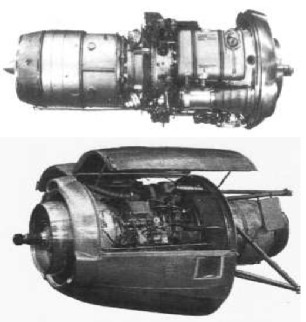
"Bristol Orion, 2 views"
Model: Orpheus
Arquitecture: Turbojet
Compressor/s: 7-stage axial compressor
Combustion chambers: Cannular combustion chambers
Turbines: Single-stage turbine
Power / Thrust: --- / 5000 Lbf
Weight: 835 Lb
The "Orpheus" is another important Bristol turbojet. Giving powers between 4,000 and 8,170 lbf. An extremely light engine, with a thrust/weight ratio of about 6 to 1, which was a very good result in that period.
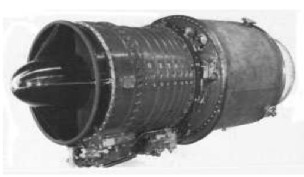
"Bristol Orpheus"
Model: P-181
Arquitecture: Turboshaft
Compressor/s: 0
Combustion chambers: 0
Turbines: 0
Power / Thrust:
Weight:
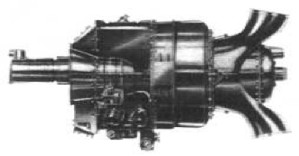
"Bristol P.181 turboprop"
Model: P-182
Arquitecture: Turboprop
Compressor/s: 0
Combustion chambers: 0
Turbines: 0
Power / Thrust:
Weight:
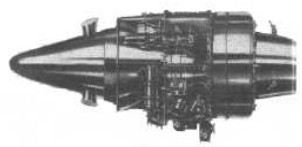
"Bristol P.182 turboprop"
Model: Palouste
Arquitecture: Gas turbine
Compressor/s: Single stage centrifugal
Combustion chambers: Annular combustion chamber
Turbines: Two-stage axial turbine
Power / Thrust:
Weight:
The Palouste was built under license from Turbomeca and was used as auxiliary turbine.
Model: Pegasus (pistón)
Arquitecture: 9-cylinder Radial
Cooling:
Total Displacement:
Bore / Stroke:
Power: 650 / 1000 HP @ rpm
Weight:
This engine began its power career at 650 hp. The Pegasus 38 with a one speed supercharger already had the power increased to 1000 hp.

"Bristol Pegasus, front view"
Model: Pegasus (Turbine) (BE-53)
Arquitecture: Turbofan
Compressor/s: 3-stage low pressure, 8-stage high pressure axia
Combustion chambers: Anular combusters
Turbines: 2-stage high pressure, 2-stage low pressure
Power / Thrust: --- / 23000 Lbf
Weight:
The Pegasus is an engine that has four outlets, two for the Fan and two for the exhaust. As they are adjustable, a vectored thrust occurs.
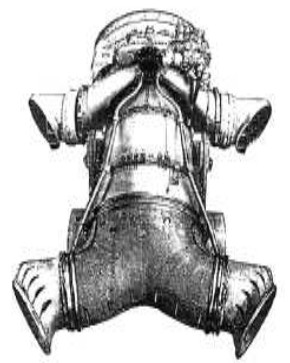
"Bristol BE53-2"
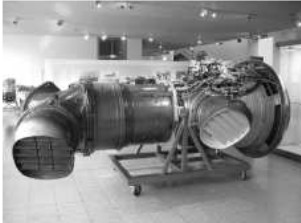
"Bristol Pegasus"
Model: Perseus
Arquitecture: 9-cylinder Radial
Cooling:
Total Displacement: 168.8 cu. in.
Bore / Stroke: 5.75 x 6.5 inch
Power: 950 HP @ 3200 rpm
Weight: 42 Lb
The first sleeve-valve engine at normal scale was the 9-cylinder, 25-liter engine called "Perseus I" (later the VIII model reached 825 hp and the X gave 950 hp).

"Bristol Perseus"
Model: Phoebus
Arquitecture: Turbojet
Compressor/s:
Combustion chambers:
Turbines:
Power / Thrust:
Weight:
The Phoebus is a Proteus turbojet version.
Model: Phoenix
Arquitecture: 9-cylinder Radial
Cooling:
Total Displacement:
Bore / Stroke:
Power: 635 HP @ rpm
Weight:
From 1934, supercharged.

"Bristol Phoenix, rear view"
Model: PR-23
Arquitecture: Rocket engine
Chambers: 0
Fuels: 0
Feed System:
Ignition:
Thrust:
Weight:
The PR-23 is retractable and act as booster.
Model: PR-37
Arquitecture: Rocket engine
Chambers: 0
Fuels: 0
Feed System:
Ignition:
Thrust:
Weight:
The PR-37 is retractable and act as booster.
Model: Proteus and Double Proteus
Arquitecture: Turboprop
Compressor/s: Inverted flow
Combustion chambers:
Turbines:
Power / Thrust: 4000SHP / ---
Weight:
Until recently, its main application was on the Bristol Britannia and the Canadair CL-44.
The "Double-Proteus" with contra-rotating propellers was installed on the Princess, a huge Saunders-Roe flying boat.

"Bristol Proteus fig.2"
Model: Sapphire
Arquitecture: Turbojet
Compressor/s: 13-stage axial flow
Combustion chambers: Anular combusters
Turbines: 2-stage turbine
Power / Thrust: --- / 12390 Lbf
Weight:
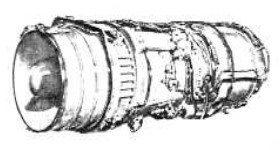
"Bristol Sapphire"
Model: Saturn
Arquitecture: Turbojet
Compressor/s:
Combustion chambers:
Turbines:
Power / Thrust: --- / 3750 Lbf
Weight:
The "Saturn" (BE-22) went on the Folland Gnat.
Model: Spectre
Arquitecture: Rocket engine
Chambers: 0
Fuels: Liquid
Feed System:
Ignition:
Thrust: 8000 Lbf
Weight:
Rocket engine. Without further details
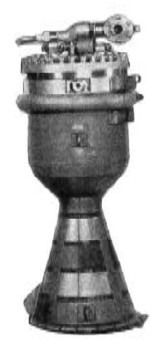
"Bristol Spectre"
Model: Stentor
Arquitecture: Rocket engine
Chambers: 0
Fuels: Liquid
Feed System:
Ignition:
Thrust:
Weight:

"Bristol - Stentor"
Model: Taurus
Arquitecture: 14-cylinder Radial
Cooling:
Total Displacement:
Bore / Stroke:
Power: @ rpm
Weight:
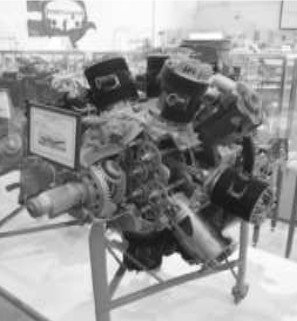
"Bristol Taurus XII"
Model: Theseus
Arquitecture: Turboprop
Compressor/s:
Combustion chambers:
Turbines:
Power / Thrust: 1950SHP / 500 Lbf
Weight:
The Theseus is from 1945 and it was the first officially approved turbine in turboprop version in the world. There was a Theseus twin version or "Double-Theseus" with two contra-rotating propellers.

"Bristol Theseus photo"
Model: Thor (BT-1 and BT-2)

"Bristol - Thor"
Model: Titan
Arquitecture: 5-cylinder Radial
Cooling:
Total Displacement:
Bore / Stroke:
Power: 200 HP @ rpm
Weight:

"Bristol - Titan"
Model: Viper
Arquitecture: Turbojet
Compressor/s: Seven-stage axial compressor
Combustion chambers: Annular combustors with 24 burners
Turbines: Single stage Turbine
Power / Thrust: --- / 2700 Lbf
Weight:
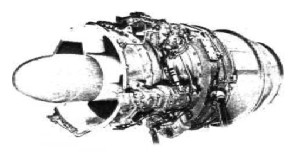
"Bristol Viper"
Model: Zephyr
Arquitecture: Turbojet
Compressor/s:
Combustion chambers:
Turbines:
Power / Thrust: --- / 16000 Lbf
Weight:
The "Zephyr" was a commercial two-shaft turbojet derived from the Olympus 2000.


